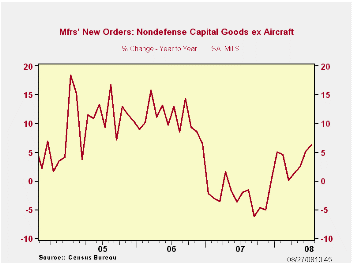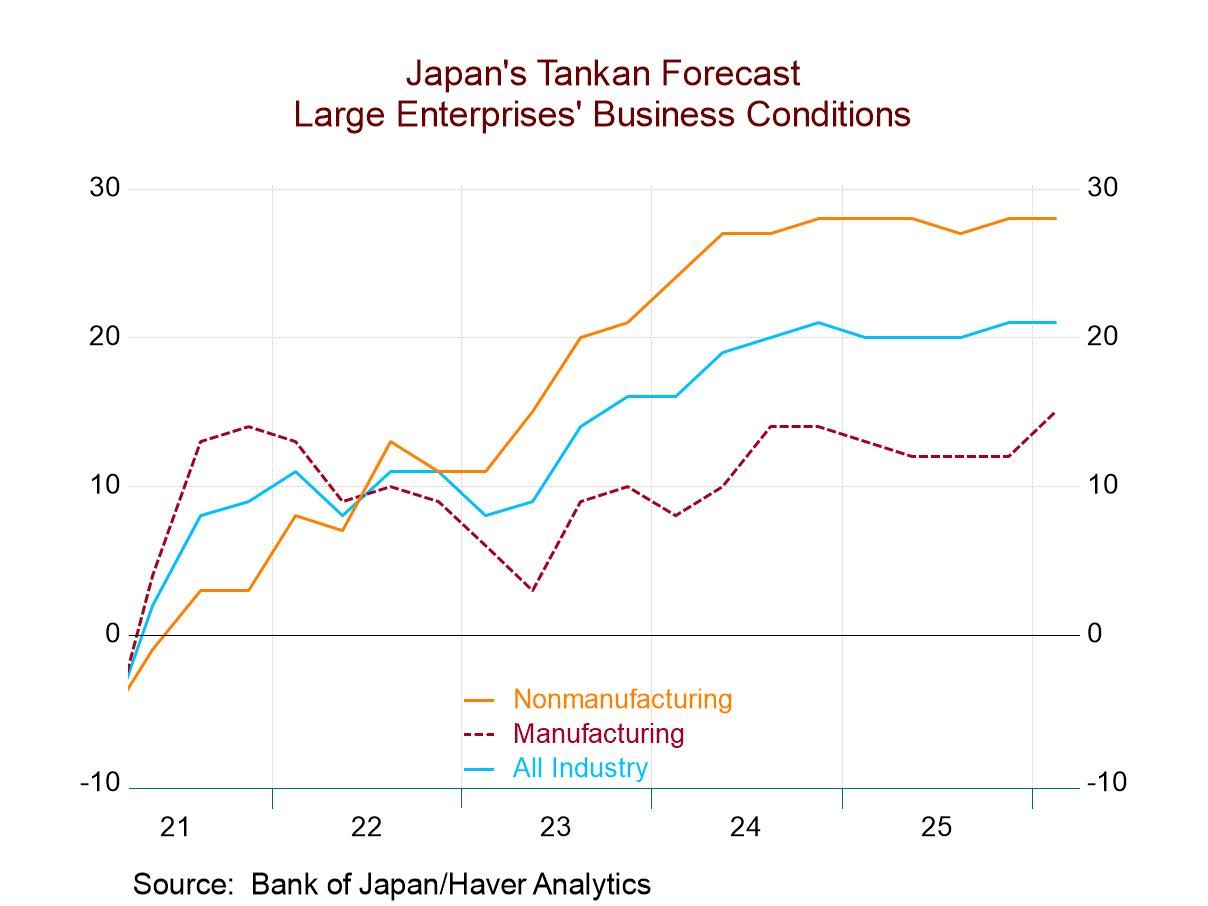 Global| Aug 27 2008
Global| Aug 27 2008U.S. Durable Goods Orders Surged Again
by:Tom Moeller
|in:Economy in Brief
Summary
For the second month in a row, new orders for durable goods jumped 1.3%. Last month's increase was led by a surge in orders for commercial aircraft, and the June gain in total orders was upwardly revised. Consensus expectations had [...]

For the second month in a row, new orders for durable goods jumped 1.3%. Last month's increase was led by a surge in orders for commercial aircraft, and the June gain in total orders was upwardly revised. Consensus expectations had been for no change in the level of July new orders. Less transportation orders rose 0.7% during July and they have risen 3.6% during the past twelve months.
Volatile orders for aircraft & parts have had an outsized effect on overall new orders for durables. They rose 21.6% (-24.8% y/y) in July after a 17.7% June drop. The nondefense portion of those orders account for most of the extreme volatility as they rose 28.0% (-37.2% y/y) last month after a 21.3% June slump.
Orders for nondefense capital goods recouped their June decline with a 6.3% jump. The volatile aircraft orders had it's outsized effect on the total, but there was strength, elsewhere, nonetheless. Less aircraft nondefense capital goods orders jumped 2.6% after a 1.3% rise during June. These orders have risen 4.0% since yearend '07 and that is a recovery from the 2.7% decline during all of last year. During the last ten years there has been an 80% correlation between the y/y gain in nondefense capital goods orders and the rise in equipment & software spending in the GDP accounts. The correlation with capital goods shipments is, as one would expect, a larger 92%.
Continuing firm were orders for machinery as they rose 4.6% (8.6% y/y) after the 2.8% increase during June. Year-to-date machinery orders are up 6.6%.Primary metals orders also have been strong and they posted a 2.2% (18.3% y/y) increase last month after their 7.8% June pop. New orders for electrical equipment did fall 6.0% (+5.5 y/y) last month and that reversed a 5.0% gain during June. The year-to-date gain in these orders, however, of 3.5% is about the same as during all of last year.
Failing to show strength were orders for computers & electronic products. They fell 1.3% (-1.9% y/y) after a 0.1% slip during June. So far this year these orders have risen just 0.3% after the 2.1% decline last year. Orders for just computers & related products fell 10.7% (-9.3% y/y) after the 4.7% skid during June. New orders for communications equipment made up some of that weakness with a 2.9% July rise (-6.6% y/y). They are up 0.4% so far this year.
Overall shipments of durable goods jumped 2.5% (-0.4% y/y) after their 0.9% June gain. So far this year these shipments are up 3.3% after last year's negligible 0.1% uptick. For comparison, industrial production of durable goods this year is down 0.7% (-0.8% y/y). During the last ten years there has been a 79% correlation between the y/y change in shipments of durable goods and the change in durables industrial production. Less transportation, shipments of durable goods rose 2.0% (3.5% y/y) after a 0.5% uptick during June
Inventories of durable goods continued strong and they rose 0.8% (7.1% y/y), the same as they did during June. Year-to-date these inventories increased 4.7%, a slight acceleration from the 3.5% rise last year. Less transportation, inventories continued firm and they also rose 0.8% (5.0% y/y) after their 1.4% rise during 2007.
The Minutes of the Federal Open Market Committee Meeting held on August 5, 2008 can be found here.
| NAICS Classification | July | June | Y/Y | 2007 | 2006 | 2005 |
|---|---|---|---|---|---|---|
| Durable Goods Orders | 1.3 | 1.3 | -4.5 | 1.4 | 6.2 | 10.2 |
| Excluding Transportation | 0.7 | 2.4 | 3.6 | -0.3 | 9.1 | 9.1 |
| Nondefense Capital Goods | 6.3 | -2.6 | -5.2 | 3.5 | 9.4 | 17.3 |
| Excluding Aircraft | 2.6 | 1.3 | 6.3 | -2.7 | 10.7 | 11.6 |
Tom Moeller
AuthorMore in Author Profile »Prior to joining Haver Analytics in 2000, Mr. Moeller worked as the Economist at Chancellor Capital Management from 1985 to 1999. There, he developed comprehensive economic forecasts and interpreted economic data for equity and fixed income portfolio managers. Also at Chancellor, Mr. Moeller worked as an equity analyst and was responsible for researching and rating companies in the economically sensitive automobile and housing industries for investment in Chancellor’s equity portfolio. Prior to joining Chancellor, Mr. Moeller was an Economist at Citibank from 1979 to 1984. He also analyzed pricing behavior in the metals industry for the Council on Wage and Price Stability in Washington, D.C. In 1999, Mr. Moeller received the award for most accurate forecast from the Forecasters' Club of New York. From 1990 to 1992 he was President of the New York Association for Business Economists. Mr. Moeller earned an M.B.A. in Finance from Fordham University, where he graduated in 1987. He holds a Bachelor of Arts in Economics from George Washington University.






